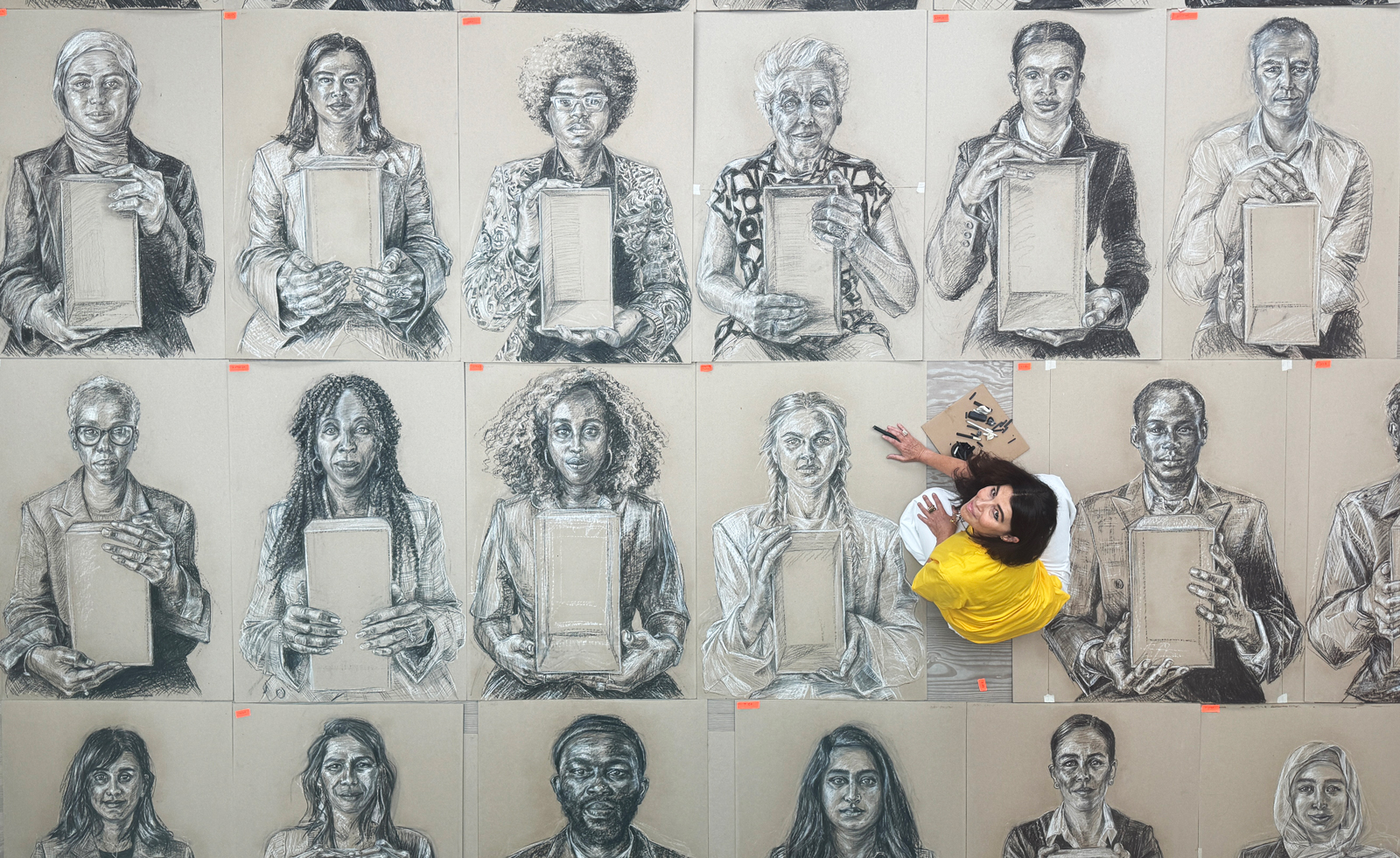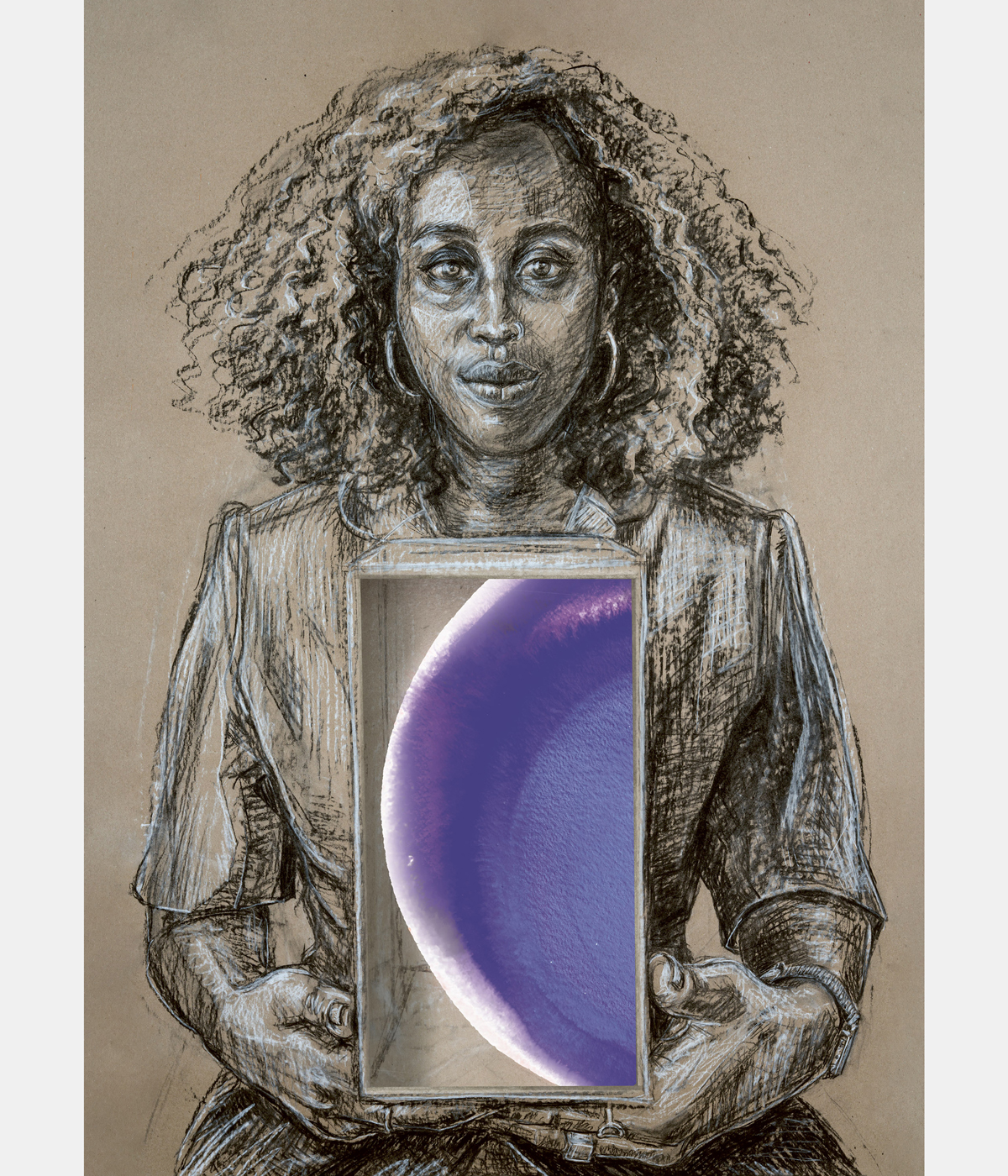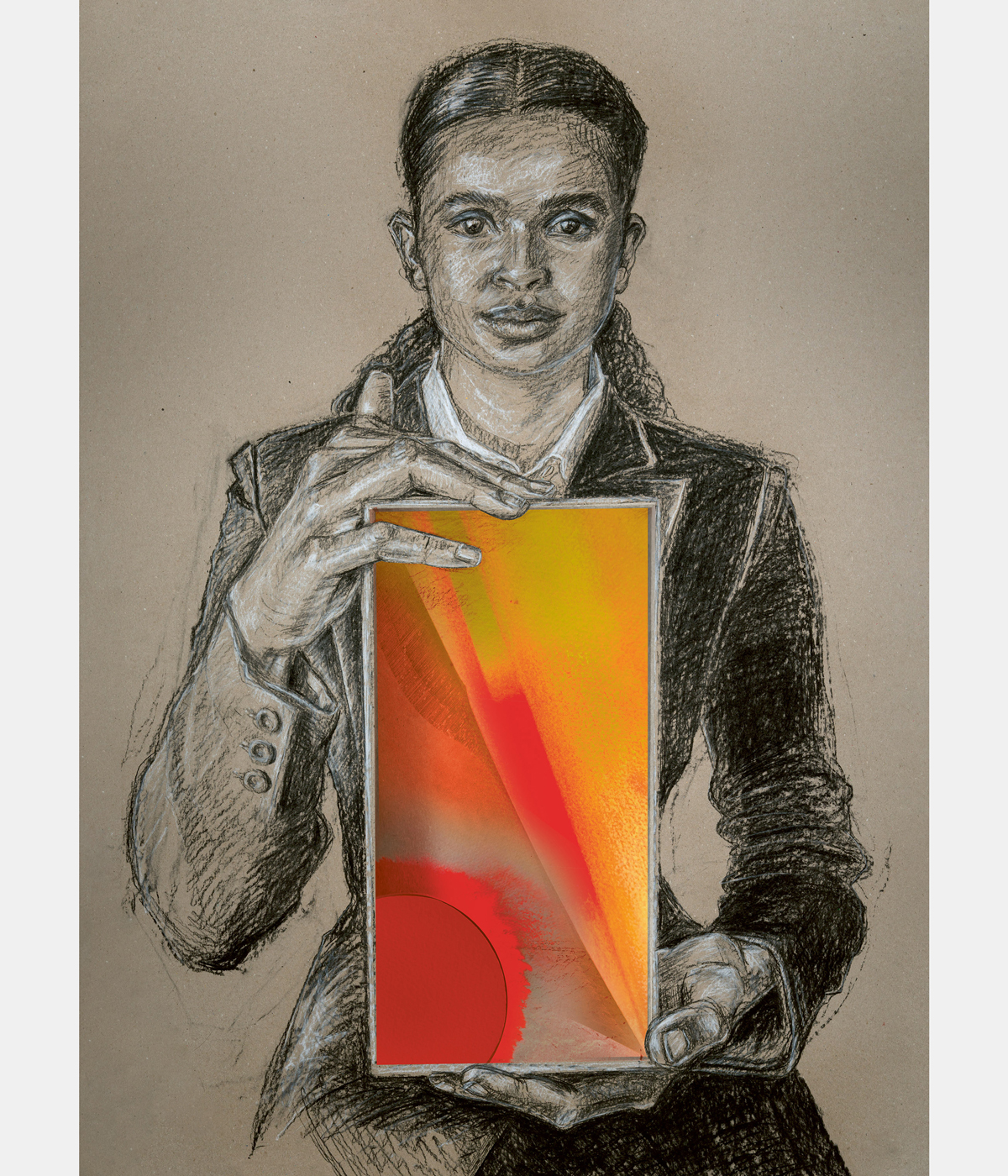Es Devlin’s large-scale choral installation celebrates London’s displaced population
Es Devlin has partnered with UK for UNHCR on a free and open-to-all exhibition, ‘Congregation’, in London from 3-9 October 2024

Es Devlin’s large-scale choral installation, Congregation, opening in London tonight (3 October 2024), considers themes of displacement, personal bias and separation in an immersive celebration of the power of acoustemology (sound as a way of knowing). Devlin, who for the project has teamed with UK for UNHCR, the United Nations Refugee Agency’s national charity partner, will be showcasing 50 portraits of Londoners who have been forcibly displaced from their home. The free and open-to-all exhibition at 18th-century church St Mary le Strand, curated by Wallpaper* contributing editor Ekow Eshun, is accompanied by choral music performed each evening outside the church.
For Devlin, who invited the subjects of her chalk and charcoal portraits to her home for their sittings, the experience was an emotional one.
‘The doorbell would ring, and I would know the first name of the person and that was it,’ says Devlin. ‘But I purposely did not know anything else. They knew the set-up – they walked in, had a cup of tea, sat down, and I immediately put the music on [Max Richter’s recomposition of Vivaldi’s Four Seasons]. I said, “We're not going to talk yet, but I do want you to look straight into my eyes. And if it's uncomfortable, then when I'm not looking at you, look around the room, but whenever I'm looking in your eyes, please look back at me”, which is an odd thing to do for 45 minutes.’

Oscar Pinto-Hervia OBE in a portrait session with Es Devlin
After the time was up, Devlin paused the music to conduct an interview, with the sitter sharing their story and revealing how they came to be in London, whether it was decades ago, as a child, or weeks ago on a small boat. The drawing then resumed while the conversation continued, with Devlin taking photos before the sitter left to enable her to complete the work alone.
‘By the time we got to that moment of telling the story, there was a real sense of relief. They were relieved to tell me who they were. I would feel really anxious about doing them justice and getting them right.’
After studying the person’s appearance for 45 minutes, Devlin was forced to confront her unconscious bias and assumptions about who they were upon hearing their story. ‘The picture would sit there while we did the interview, just accusing me. With Maya [Ghazal], I had never drawn a woman in a hijab before, and I got really involved in this beautiful woman, how the hijab went exactly there, how the light came through. Of course, we did the interview and she said, “Right, I'm a commercial pilot. I fly 737s.” And I just felt like such an idiot. What was I doing, faffing about with her hijab when I should be on her pilot's black, chunky watch? If I'd known she was a pilot, I would have gone on about the watch. But you don't have access to this information, so you go to what your associations are, and that's what I really wanted to draw attention to myself. I thought if it's in me, it'll be in everyone.’

Es Devlin portrait of Ornella Mutoni
In the drawings, subjects are pictured holding a box that contains a projected animated sequence that they have created. Devlin views the resulting works as co-authored, the result of a dialogue between herself and the participant that subverts a mainstream narrative. By each sitter being viewed through a shared lens, the external and objectifying gaze is eschewed, giving a face and a voice to the persecuted and the voiceless.
Receive our daily digest of inspiration, escapism and design stories from around the world direct to your inbox.

Es Devlin portrait of Dame Stephanie (Steve) Shirley
In choosing to create these images in haunting charcoal and chalk, Devlin draws on an emotive canon of portraiture inspired by Lucien Freud’s sketchbooks, as well as Frank Auerbach’s charcoal portraits, which were on show at the Courtauld earlier in the year. She views Congregation, with its sole focus on the inhabitants of London, as a sister work to 2022’s Come Home Again, in which she presented drawings of London’s wildlife. ‘This piece is not about all the world's refugees,’ Devlin adds. ‘This piece is really about London. I think that the best way into the general and the universe is to be very particular, so in this case, it is about a very specific community. And what I would say about this community that came in and out of my doors here is, this is us. This is London.’
Es Devlin will unveil Congregation, a new large-scale choral installation she has created in partnership with UK for UNHCR, the United Nations Refugee Agency’s national charity partner, at St Mary le Strand from 3 – 9 October 2024. The work, has been developed in collaboration with King’s College London in partnership with The Courtauld.
The work will be free and open to the public daily from 10am till 6pm, with free public choral performances within the surrounding pedestrianised area of The Strand outside The Courtauld at 7pm each evening, from Thursday 3 October until Wednesday 9 October, to coincide with Frieze London 2024

Es Devlin portrait of Ramla Ali
Hannah Silver is the Art, Culture, Watches & Jewellery Editor of Wallpaper*. Since joining in 2019, she has overseen offbeat art trends and conducted in-depth profiles, as well as writing and commissioning extensively across the worlds of culture and luxury. She enjoys travelling, visiting artists' studios and viewing exhibitions around the world, and has interviewed artists and designers including Maggi Hambling, William Kentridge, Jonathan Anderson, Chantal Joffe, Lubaina Himid, Tilda Swinton and Mickalene Thomas.
-
 Georgia Kemball's jewellery has Dover Street Market's stamp of approval: discover it here
Georgia Kemball's jewellery has Dover Street Market's stamp of approval: discover it hereSelf-taught jeweller Georgia Kemball is inspired by fairytales for her whimsical jewellery
-
 The best way to see Mount Fuji? Book a stay here
The best way to see Mount Fuji? Book a stay hereAt the western foothills of Mount Fuji, Gora Kadan’s second property translates imperial heritage into a deeply immersive, design-led retreat
-
 12 fashion figures reveal their style resolutions for the year ahead
12 fashion figures reveal their style resolutions for the year aheadAs 2025 comes to a close, we ask the Wallpaper* style community – from Willy Chavarria and Stefan Cooke to Craig Green and Torishéju Dumi – their New Year's resolutions
-
 Out of office: The Wallpaper* editors’ picks of the week
Out of office: The Wallpaper* editors’ picks of the week'Tis the season for eating and drinking, and the Wallpaper* team embraced it wholeheartedly this week. Elsewhere: the best spot in Milan for clothing repairs and outdoor swimming in December
-
 Out of office: The Wallpaper* editors’ picks of the week
Out of office: The Wallpaper* editors’ picks of the weekFar from slowing down for the festive season, the Wallpaper* team is in full swing, hopping from events to openings this week. Sometimes work can feel like play – and we also had time for some festive cocktails and cinematic releases
-
 The Barbican is undergoing a huge revamp. Here’s what we know
The Barbican is undergoing a huge revamp. Here’s what we knowThe Barbican Centre is set to close in June 2028 for a year as part of a huge restoration plan to future-proof the brutalist Grade II-listed site
-
 Out of office: The Wallpaper* editors’ picks of the week
Out of office: The Wallpaper* editors’ picks of the weekIt’s wet, windy and wintry and, this week, the Wallpaper* team craved moments of escape. We found it in memories of the Mediterranean, flavours of Mexico, and immersions in the worlds of music and art
-
 Each mundane object tells a story at Pace’s tribute to the everyday
Each mundane object tells a story at Pace’s tribute to the everydayIn a group exhibition, ‘Monument to the Unimportant’, artists give the seemingly insignificant – from discarded clothes to weeds in cracks – a longer look
-
 Out of office: The Wallpaper* editors’ picks of the week
Out of office: The Wallpaper* editors’ picks of the weekThis week, the Wallpaper* team had its finger on the pulse of architecture, interiors and fashion – while also scooping the latest on the Radiohead reunion and London’s buzziest pizza
-
 Out of office: The Wallpaper* editors’ picks of the week
Out of office: The Wallpaper* editors’ picks of the weekIt’s been a week of escapism: daydreams of Ghana sparked by lively local projects, glimpses of Tokyo on nostalgic film rolls, and a charming foray into the heart of Christmas as the festive season kicks off in earnest
-
 Wes Anderson at the Design Museum celebrates an obsessive attention to detail
Wes Anderson at the Design Museum celebrates an obsessive attention to detail‘Wes Anderson: The Archives’ pays tribute to the American film director’s career – expect props and puppets aplenty in this comprehensive London retrospective